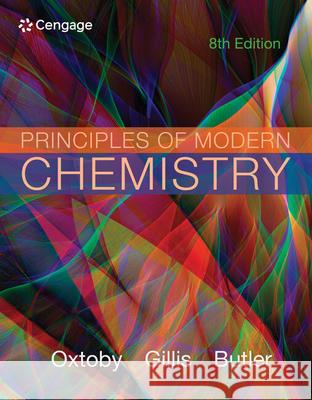Principles of Modern Chemistry » książka



Principles of Modern Chemistry
ISBN-13: 9780357671009 / Angielski / Miękka / 2021
Principles of Modern Chemistry
ISBN-13: 9780357671009 / Angielski / Miękka / 2021
(netto: 418,72 VAT: 5%)
Najniższa cena z 30 dni: 436,25 zł
ok. 30 dni roboczych.
Darmowa dostawa!
Unit I. Introduction to the Study of Modern Chemistry.1. The Atom in Modern Chemistry.2. Chemical Formulas, Equations, and Reaction Yields.Unit II. Chemical Bonding and Molecular Structure.3. Atomic Shells and Classical Models of Chemical Bonding.4. Introduction to Quantum Mechanics.5. Quantum Mechanics and Atomic Structure.6. Quantum Mechanics and Molecular Structure.7. Bonding in Organic Molecules.8. Bonding in Transition Metal Compounds and Coordination Complexes.Unit III. Kinetic Molecular Description of the States of Matter.9. The Gaseous State.10. Solids, Liquids, and Phase Transitions.11. Solutions.Unit IV. Equilibrium in Chemical Reactions.12. Thermodynamic Processes and Thermochemistry.13. Spontaneous Processes and Thermodynamic Equilibrium.14. Chemical Equilibrium.15. Acid Base Equilibria.16. Solubility and Precipitation Equilibria.17. Electrochemistry.Unit V. Rates of Chemical and Physical Processes.18. Chemical Kinetics.19. Nuclear Chemistry.20. Molecular Spectroscopy and Photochemistry.Unit VI. Materials.21. Structure and Bonding in Solids.22. Inorganic Materials.23. Polymeric Materials and Soft Condensed Matter.Appendix A. Scientific Notation and Experimental Error.Appendix B. SI Units, Unit Conversions, and Physics for General Chemistry.Appendix C. Mathematics for General Chemistry.Appendix D. Standard Chemical Thermodynamic Properties.Appendix E. Standard Reaction Potentials at 25 C.Appendix F. Physical Properties of the Elements.Appendix G. Solutions to the Odd-Numbered Problems.Index/Glossary.
H.P. Gillis conducts experimental research in the physical chemistry of electronic materials, emphasizing phenomena at solid surfaces and interfaces. Dr. Gillis received his B.S. (Chemistry and Physics) at Louisiana State University and his Ph.D. (Chemical Physics) at The University of Chicago. After postdoctoral research at the University of California-Los Angeles and 10 years with the technical staff at Hughes Research Laboratories in Malibu, California, Dr. Gillis joined the faculty of Georgia Institute of Technology. Dr. Gillis moved to University of California-Los Angeles, where he currently serves as Adjunct Professor of Materials Science and Engineering. He has taught courses in general chemistry, physical chemistry, quantum mechanics, surface science, and materials science at UCLA and at Georgia Institute of Technology. David W. Oxtoby became the ninth president of Pomona College on July 1, 2003. An internationally noted chemist, he previously served as dean of physical sciences at the University of Chicago. At Pomona, he holds a coterminous appointment as president and professor of chemistry. Before coming to Pomona, he was associated with the University of Chicago for nearly three decades, with brief interludes to serve as a visiting professor at such places as the University of Paris; the University of Bristol in Great Britain; and the University of Sydney in Australia. Oxtoby is a fellow of the American Physical Society and a member of the American Chemical Society and the American Association for the Advancement of Science. After earning his bachelor's degree, summa cum laude, from Harvard University, he went on to earn his Ph.D. at the University of California, Berkeley. As a research chemist, he is author or co-author of more than 165 scientific articles on such subjects as light scattering, chemical reaction dynamics and phase transitions. In addition to co-authoring Principles of Modern Chemistry and Chemistry: Science of Change, he has received fellowships from the Guggenheim, von Humboldt, Dreyfus, Sloan, Danforth and National Science foundations. Laurie J. Butler received her B.S. at the Massachusetts Institute of Technology, and her Ph.D. at the University of California, Berkeley. After postdoctoral research at the University of Wisconsin, she joined the faculty at The University of Chicago, where she has been a professor since 1987. Professor Butler's research investigates the fundamental inter- and intramolecular forces that drive the course of chemical reactions. Much of her recent work investigates classes of important chemical reactions where the breakdown of the Born-Oppenheimer approximation (the inability of the electronic wavefunction to readjust rapidly enough during the nuclear dynamics) near the transition state alters the dynamics and markedly reduces the reaction rate. She has been an Alfred P. Sloan Fellow and a Camille and Henry Dreyfus Teacher-Scholar, and was awarded the Llewellyn John and Harriet Manchester Quantrell Award for Excellence in Undergraduate Teaching at The University of Chicago.
1997-2025 DolnySlask.com Agencja Internetowa
KrainaKsiazek.PL - Księgarnia Internetowa









